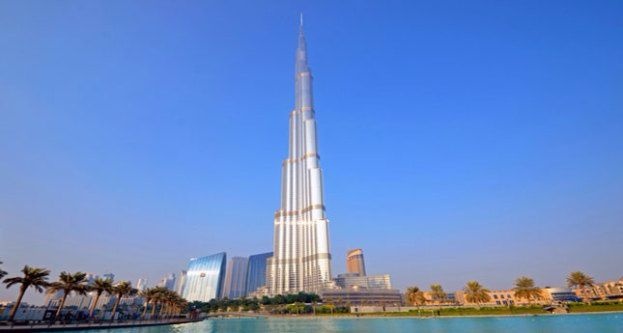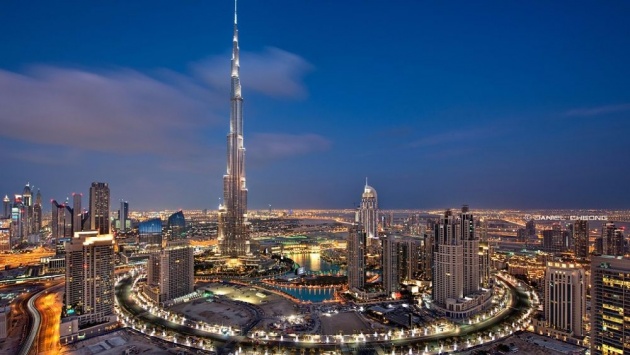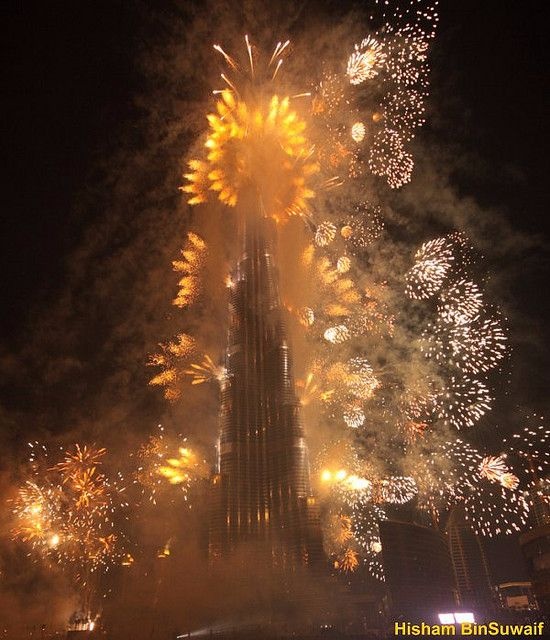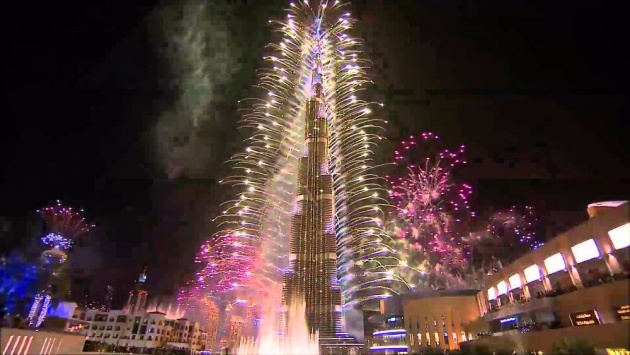Second Taj Opens In Dubai

"Burj Dubai" redirects here. It is not to be confused with Bur Dubai, a district of Dubai.
Burj Khalifa
برج خليفة
Burj Khalifa.jpg
The Burj Khalifa in October 2012
Former names Burj Dubai
Record height
Tallest in the world since 2009
Preceded by Taipei 101
General information
Type Mixed-use
Architectural style Neo-futurism
Location 1 Sheikh Mohammed bin Rashid Boulevard, Dubai, United Arab Emirates
Coordinates 25°11′49.7″N 55°16′26.8″ECoordinates: 25°11′49.7″N 55°16′26.8″E
Construction started 6 January 2004
Completed 30 December 2009
Opening 4 January 2010
Cost USD $ 1.5 billion
Height
Architectural 828 m (2,717 ft)
Tip 829.8 m (2,722 ft)
Roof 828 m (2,717 ft)
Top floor 584.5 m (1,918 ft) (Level 154)
Observatory 555.7 m (1,823 ft) (Level 148)
Technical details
Floor count 154 usable floors
plus 9 maintenance levels, 46 spire levels,and 2 below-ground parking levels
Floor area 309,473 m2 (3,331,100 sq ft)
Lifts/elevators 57 (55 single deck and 2 double deck), made by Otis Elevator Company
Design and construction
Architect Adrian Smith at SOM
Developer Emaar Properties
Structural engineer Bill Baker at SOM
Main contractor Samsung C&T Corporation, Besix and Arabtec
Supervision Consultant Engineer & Architect of Record Hyder Consulting
Construction Project Manager Turner Construction
Grocon
Planning Bauer AG and Middle East Foundations
Lift contractor Otis
VT consultant Lerch Bates
Website
www.burjkhalifa.ae
Burj Khalifa (Arabic: برج خليفة, "Khalifa Tower", pronounced English /ˈbɜrdʒ kəˈliːfə/), known as Burj Dubai before its inauguration, is a megatall skyscraper in Dubai, United Arab Emirates. It is the tallest artificial structure in the world, standing at 829.8 m (2,722 ft).[3][8]
Construction of Burj Khalifa began in 2004, with the exterior completed in 2009. The primary structure is reinforced concrete. The building opened in 2010, as part of the new development called Downtown Dubai. It is designed to be the centerpiece of large-scale, mixed-use development. The decision to build the building is reportedly based on the government's decision to diversify from an oil-based economy, and for Dubai to gain international recognition. The building was named in honor of the ruler of Abu Dhabi and president of the United Arab Emirates, Khalifa bin Zayed Al Nahyan; Abu Dhabi and the UAE government lent Dubai money to pay its debts. The building broke numerous height records.
Burj Khalifa was designed by Adrian Smith then of Skidmore, Owings and Merrill (SOM), whose firm also designed the Willis Tower and the One World Trade Center. Hyder Consulting was chosen to be the supervising engineer with NORR Group Consultants International Limited chosen to supervise the architecture of the project. The design of Burj Khalifa is derived from patterning systems embodied in Islamic architecture, incorporating cultural and historical elements particular to the region such as the spiral minaret. The Y-shaped plan is designed for residential and hotel usage. A buttressed core structural system is used to support the height of the building, and the cladding system is designed to withstand Dubai's summer temperatures. A total of 57 elevators and 8 escalators are installed, with the elevators having a capacity of 12 to 14 people per cabin. Critical reception to Burj Khalifa has been generally positive, and the building received many awards. However, the labor issues during construction have been controversial, since the building was built primarily by workers from South Asia and East Asia, who earned low wages and were reportedly housed in poor conditions.

Development
Construction began on 6 January 2004, with the exterior of the structure completed on 1 October 2009. The building officially opened on 4 January 2010,and is part of the new 2 km2 (490-acre) development called Downtown Dubai at the 'First Interchange' along Sheikh Zayed Road, near Dubai's main business district. The tower's architecture and engineering were performed by Skidmore, Owings and Merrill of Chicago, with Adrian Smith as chief architect, and Bill Baker as chief structural engineer.The primary contractor was Samsung C&T of South Korea.The tower's construction was done by the construction division of Al Ghurair Investment group.
Conception
Burj Khalifa was designed to be the centerpiece of a large-scale, mixed-use development that would include 30,000 homes, nine hotels (including The Address Downtown Dubai), 3 hectares (7.4 acres) of parkland, at least 19 residential towers, the Dubai Mall, and the 12-hectare (30-acre) man-made Burj Khalifa Lake. The decision to build Burj Khalifa is reportedly based on the government's decision to diversify from an oil based economy to one that is service and tourism based. According to officials, it is necessary for projects like Burj Khalifa to be built in the city to garner more international recognition, and hence investment. "He (Sheikh Mohammed bin Rashid Al Maktoum) wanted to put Dubai on the map with something really sensational," said Jacqui Josephson, a tourism and VIP delegations executive at Nakheel Properties. The tower was known as Burj Dubai ("Dubai Tower") until its official opening in January 2010. It was renamed in honor of the ruler of Abu Dhabi and president of the United Arab Emirates, Khalifa bin Zayed Al Nahyan; Abu Dhabi and the federal government of UAE lent Dubai tens of billions of USD so that Dubai could pay its debts Dubai borrowed at least $80 billion for construction projects. In 2000s, Dubai started diversifying its economy but it suffered from an economic crisis in 2007–2010, leaving large scale projects already in construction abandoned.
Records
Tallest existing structure: 829.8 m (2,722 ft) (previously KVLY-TV mast – 628.8 m or 2,063 ft)
Tallest structure ever built: 829.8 m (2,722 ft) (previously Warsaw radio mast – 646.38 m or 2,121 ft)
Tallest freestanding structure: 829.8 m (2,722 ft) (previously CN Tower – 553.3 m or 1,815 ft)
Tallest skyscraper (to top of spire): 829.8 m (2,722 ft) (previously Taipei 101 – 509.2 m or 1,671 ft)
Tallest skyscraper to top of antenna: 829.8 m (2,722 ft) (previously the Willis (formerly Sears) Tower – 527.3 m or 1,730 ft)
Building with most floors: 163 (previously World Trade Center – 110)
Building with world's highest occupied floor: 584.5 m (1,918 ft)
World's highest elevator installation (situated inside a rod at the very top of the building)
World's longest travel distance elevators: 504 m (1,654 ft)
Highest vertical concrete pumping (for a building): 606 m (1,988 ft)
World's tallest structure that includes residential space
World's highest observation deck: 148th floor at 555 m (1,821 ft)
World's highest outdoor observation deck: 124th floor at 452 m (1,483 ft)
World's highest installation of an aluminium and glass façade: 512 m (1,680 ft)
World's highest nightclub: 144th floor
World's highest restaurant (At.mosphere): 122nd floor at 442 m (1,450 ft) (previously 360, at a height of 350 m (1,148 ft) in CN Tower)
World's highest New Year display of fireworks.
World's second highest swimming pool: 76th floor (world's highest swimming pool is located on 118th floor of Ritz-Carlton Hotel at International Commerce Centre, Hong Kong).
History of height increases
Burj Khalifa compared with some other well-known tall structures
There are unconfirmed reports of several planned height increases since its inception. Originally proposed as a virtual clone of the 560 m (1,837 ft) Grollo Tower proposal for Melbourne, Australia's Docklands waterfront development, the tower was redesigned by Skidmore, Owings and Merrill (SOM). Marshall Strabala, an SOM architect who worked on the project until 2006, in late 2008 said that Burj Khalifa was designed to be 808 m (2,651 ft) tall
The design architect, Adrian Smith, felt that the uppermost section of the building did not culminate elegantly with the rest of the structure, so he sought and received approval to increase it to the current height.[citation needed] It has been explicitly stated that this change did not include any added floors, which is fitting with Smith's attempts to make the crown more slender.
Delay
Emaar Properties announced on 9 June 2008 that construction of Burj Khalifa was delayed by upgraded finishes and would be completed only in September 2009.[35] An Emaar spokesperson said "The luxury finishes that were decided on in 2004, when the tower was initially conceptualized, is now being replaced by upgraded finishes. The design of the apartments has also been enhanced to make them more aesthetically attractive and functionally superior.A revised completion date of 2 December 2009 was then announced.However, Burj Khalifa was opened on 4 January 2010, more than a month later.
Architecture and design
Cross-section comparisons of various towers. From top to bottom: Burj Khalifa, Taipei 101, Willis Tower, World Trade Center.
The tower was designed by Skidmore, Owings and Merrill (SOM), who also designed the Willis Tower (formerly the Sears Tower) in Chicago and the new One World Trade Center in New York City. Burj Khalifa uses the bundled tube design of the Willis Tower, invented by Fazlur Rahman Khan.Proportionally, the design uses half the amount of steel used in the construction of the Empire State Building thanks to the tubular system.Its design is reminiscent of Frank Lloyd Wright's vision for The Illinois, a mile high skyscraper designed for Chicago. According to Marshall Strabala, a SOM architect who worked on the building's design team, Burj Khalifa was designed based on the 73 floor Tower Palace Three, an all residential building in Seoul. In its early planning, Burj Khalifa was intended to be entirely residential.
Subsequent to the original design by Skidmore, Owings and Merrill, Emaar Properties chose Hyder Consulting to be the supervising engineer with NORR Group Consultants International Limited chosen to supervise the architecture of the project.Hyder was selected for its expertise in structural and MEP (mechanical, electrical and plumbing) engineering.Hyder Consulting's role was to supervise construction, certify SOM's design, and be the engineer and architect of record to the UAE authorities.NORR's role was the supervision of all architectural components including on site supervision during construction and design of a 6-storey addition to the Office Annex Building for architectural documentation. NORR was also responsible for the architectural integration drawings for the Armani Hotel included in the Tower. Emaar Properties also engaged GHD,an international multidisciplinary consulting firm, to act as an independent verification and testing authority for concrete and steelwork.


The spiral minaret at the Great Mosque of Samarra
The design of Burj Khalifa is derived from patterning systems embodied in Islamic architecture According to the structural engineer, Bill Baker of SOM, the building's design incorporates cultural and historical elements particular to the region such as the spiral minaret. The spiral minaret spirals and grows slender as it rises.The Y-shaped plan is ideal for residential and hotel usage, with the wings allowing maximum outward views and inward natural light.As the tower rises from the flat desert base, there are 27 setbacks in a spiralling pattern, decreasing the cross section of the tower as it reaches toward the sky and creating convenient outdoor terraces. At the top, the central core emerges and is sculpted to form a finishing spire. At its tallest point, the tower sways a total of 1.5 m (4.9 ft).
As part of a study which reveals the unnecessary "vanity space" added to the top of the world's tallest buildings by the Council on Tall Buildings and Urban Habitat (CTBUH), it was revealed that without its 244-metre spire, the 828-metre Burj Khalifa would drop to a substantially smaller 585-metre height without any reduction in usable space. As the report states, the spire "could be a skyscraper on its own"
To support the unprecedented height of the building, the engineers developed a new structural system called the buttressed core, which consists of a hexagonal core reinforced by three buttresses that form the ‘Y' shape. This structural system enables the building to support itself laterally and keeps it from twisting.
The spire of Burj Khalifa is composed of more than 4,000 tonnes (4,400 short tons; 3,900 long tons) of structural steel. The central pinnacle pipe weighing 350 tonnes (390 short tons; 340 long tons) was constructed from inside the building and jacked to its full height of over 200 m (660 ft) using a strand jack system. The spire also houses communications equipment.
In 2009, architects announced that more than 1,000 pieces of art would adorn the interiors of Burj Khalifa, while the residential lobby of Burj Khalifa would display the work of Jaume Plensa, featuring 196 bronze and brass alloy cymbals representing the 196 countries of the world.It was planned that the visitors in this lobby would be able to hear a distinct timbre as the cymbals, plated with 18-carat gold, are struck by dripping water, intended to mimic the sound of water falling on leaves.
The cladding system is designed to withstand Dubai's extreme summer temperatures, and consists of 142,000 m2 (1,528,000 sq ft) of reflective glazing, and aluminium and textured stainless steel spandrel panels with vertical tubular fins. Over 26,000 glass panels were used in the exterior cladding of Burj Khalifa, and more than 300 cladding specialists from China were brought in for the cladding work on the tower.The architectural glass provides solar and thermal performance as well as an anti-glare shield for the intense desert sun, extreme desert temperatures and strong winds. In total the glass covers more than 174,000 m2 (1,870,000 sq ft)citation needed]
The exterior temperature at the top of the building is thought to be 6 °C (11 °F) cooler than at its base.
A 304-room Armani Hotel, the first of four by Armani, occupies 15 of the lower 39 floors.The hotel was supposed to open on 18 March 2010,but after several delays, it finally opened to the public on 27 April 2010.The corporate suites and offices were also supposed to open from March onwards,yet the hotel and observation deck remained the only parts of the building which were open in April 2010.
The sky lobbies on the 43rd and 76th floors house swimming pools.Floors through to 108 have 900 private residential apartments (which, according to the developer, sold out within eight hours of being on the market). An outdoor zero-entry swimming pool is located on the 76th floor of the tower. Corporate offices and suites fill most of the remaining floors, except for a 122nd, 123rd and 124th floor where the At.mosphere restaurant, sky lobby and an indoor and outdoor observation deck is located respectively. In January 2010, it was planned that Burj Khalifa would receive its first residents from February 2010
A total of 57 elevators and 8 escalators are installed.The elevators have a capacity of 12 to 14 people per cabin, the fastest rising and descending at up to 10 m/s (33 ft/s) for double-deck elevators. However, the world's fastest single-deck elevator still belongs to Taipei 101 at 16.83 m/s (55.2 ft/s). Engineers had considered installing the world's first triple-deck elevators, but the final design calls for double-deck elevators.The double-deck elevators are equipped with entertainment features such as LCD displays to serve visitors during their travel to the observation deck.The building has 2,909 stairs from the ground floor to the 160th floor.The graphic design identity work for Burj Khalifa is the responsibility of Brash Brands, who are based in Dubai. Design of the global launch events, communications, and visitors centers for Burj Khalifa have also been created by Brash Brands as well as the roadshow exhibition for the Armani Residences, which are part of the Armani Hotel within Burj Khalifa, which toured Milan, London, Jeddah, Moscow and Delhi.
Plumbing systems
The Burj Khalifa's water system supplies an average of 946,000 L (250,000 U.S. gal) of water per day through 100 km (62 mi) of pipes.An additional 213 km (132 mi) of piping serves the fire emergency system, and 34 km (21 mi) supplies chilled water for the air conditioning system.The waste water system uses gravity to discharge water from plumbing fixtures, floor drains, mechanical equipment and storm water, to the city municipal sewer.
Air conditioning
The air conditioning system draws air from the upper floors where the air is cooler and cleaner than on the ground.At peak cooling times, the tower's cooling is equivalent to that provided by 13,000 short tons (26,000,000 lb) of melting ice in one day,or about 46 MW.[clarification needed] The condensate collection system, which uses the hot and humid outside air, combined with the cooling requirements of the building, results in a significant amount of condensation of moisture from the air. The condensed water is collected and drained into a holding tank located in the basement car park; this water is then pumped into the site irrigation system for use on the Burj Khalifa park.
Window cleaning
To wash the 24,348 windows, totaling 120,000 m2 (1,290,000 sq ft) of glass, a horizontal track has been installed on the exterior of Burj Khalifa at levels 40, 73, and 109. Each track holds a 1,500 kg (3,300 lb) bucket machine which moves horizontally and then vertically using heavy cables. Above level 109, up to tier 27 traditional cradles from davits are used. The top of the spire, however, is reserved for specialist window cleaners, who brave the heights and high winds, dangling on ropes to clean and inspect the top of the pinnacle.Under normal conditions, when all building maintenance units will be operational, it will take 36 workers three to four months to clean the entire exterior façade.
Unmanned machines will clean the top 27 additional tiers and the glass spire. The cleaning system was developed in Melbourne, Australia at a cost of A$8 million.The contract for building the state-of-the-art machines was won by Australian company Cox Gomyl.
Features
The Dubai Fountain
The Dubai Fountain
Main article: The Dubai Fountain
Outside, WET Enterprises designed a fountain system at a cost of Dh 800 million (US$217 million). Illuminated by 6,600 lights and 50 coloured projectors, it is 275 m (902 ft) long and shoots water 150 m (490 ft) into the air, accompanied by a range of classical to contemporary Arabic and world music.On 26 October 2008, Emaar announced that based on results of a naming contest the fountain would be called the Dubai Fountain.
View of Downtown Dubai from the observation deck
Observation deck
An outdoor observation deck, named At the Top, opened on 5 January 2010 on the 124th floor. At 452 m (1,483 ft), it was the highest observation deck in the world and the highest outdoor observation deck in the world when it opened. Although it was surpassed in December 2011 by Cloud Top 488 on the Canton Tower at 488 m (1,601 ft),Burj Khalifa opened the 148th floor SKY level at 555 m (1,821 ft), once again giving it the highest observation deck in the world on 15 October 2014.The 124th floor observation deck also features the Tellscope electronic telescope, an augmented reality device developed by gsmprjct° of Montréal, which allows visitors to view the surrounding landscape in real-time, and to view previously saved images such as those taken at different times of day or under different weather conditions. To manage the daily rush of sightseers, visitors are able to purchase tickets in advance for a specific date and time and at a 75% discount over tickets purchased on the spot.
On 8 February 2010, the observation deck was closed to the public after power-supply problems caused an elevator to become stuck between floors, trapping a group of tourists for 45 minutes.Despite rumours of the observation deck reopening for St. Valentine's Day (14 February),it remained closed until 4 April 2010.
Burj Khalifa park
Burj Khalifa is surrounded by an 11 ha (27-acre) park designed by landscape architects SWA Group.The design of the park is also inspired by the core design concepts of Burj Khalifa which is based on the symmetries of the desert flower, Hymenocallis.The park has six water features, gardens, palm lined walkways, and flowering trees. At the centre of the park and the base of Burj Khalifa is the water room, which is a series of pools and water jet fountains. In addition the railing, benches and signs incorporate images of Burj Khalifa and the Hymenocallis flower.
The plants and the shrubbery will be watered by the buildings's condensation collection system that uses water from the cooling system. The system will provide 68,000,000 L (15,000,000 imp gal) annually.WET Enterprises, who also developed the Dubai Fountain, developed the park's six water features.
Floor plans
The following is a breakdown of floors.



